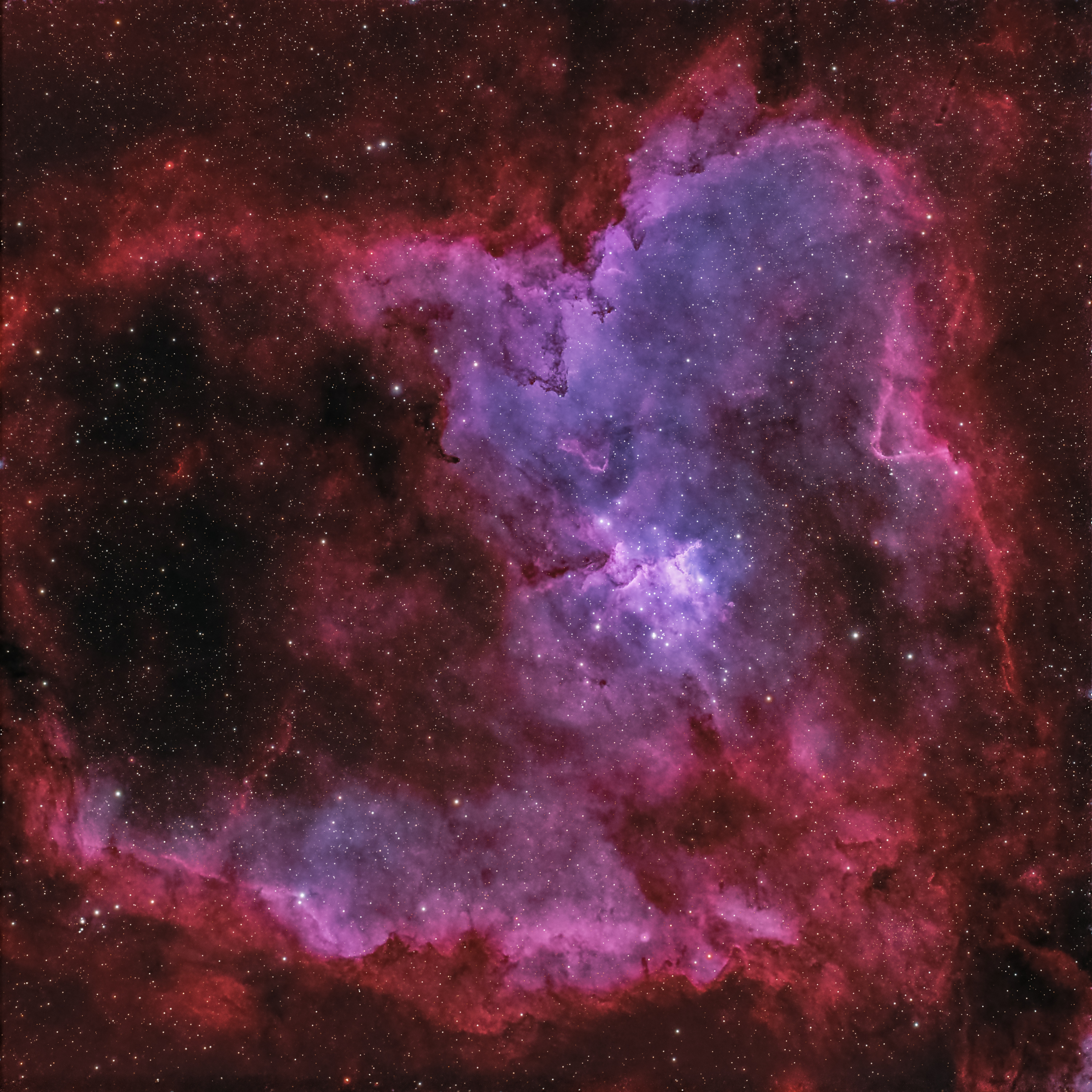
Telescope: Sky-Watcher 72ed Evostar
Mount: Sky-Watcher HEQ-5 Pro
Camera: ZWO ASI 533MC-Pro
Gain: 100
Filter: Optolong L’Enhance 1.25 Inch
Totale exposure: 84 x 300 sec / 7 hours
Guide Scope: ZWO MINI Guide Scope
Guide Camera: ZWO ASI 120MM
Exploring IC 1805: The Heart Nebula
The night sky is filled with wonders, and one of the most captivating sights is IC 1805, also known as the Heart Nebula. Located in the constellation Cassiopeia, this stunning nebula gets its name from its heart-like shape. In this blog, we’ll dive into the beauty of the Heart Nebula and explore how you can photograph it using a camera like the ZWO ASI 533MC Pro with broadband filters like the Optolong L-eNhance or L-eXtreme.
What is the Heart Nebula?
The Heart Nebula, IC 1805, is a massive region of ionized hydrogen gas and interstellar dust. It spans about 200 light-years across and is located approximately 7,500 light-years away from Earth. This nebula is an emission nebula, which means it emits light at specific wavelengths due to the ionization of hydrogen atoms. The glowing red color of the Heart Nebula comes from the emission of hydrogen-alpha light.
The Heart Nebula is home to a young, open star cluster called Melotte 15. This cluster contains hot, massive stars that generate intense radiation, shaping the surrounding gas and dust into fascinating structures. These bright stars illuminate the nebula, creating the spectacular view we see through our telescopes and cameras.
Photographing the Heart Nebula
Capturing the beauty of the Heart Nebula requires some planning and the right equipment. One excellent camera for this task is the ZWO ASI 533MC Pro. This camera is designed specifically for astrophotography, making it a perfect choice for beginners and experienced astrophotographers alike.
Why the ZWO ASI 533MC Pro?
The ZWO ASI 533MC Pro is a versatile and powerful camera for deep-sky imaging. Here are some reasons why it’s great for photographing the Heart Nebula:
- High Sensitivity: The camera’s sensor is highly sensitive to light, allowing it to capture faint details in nebulae and galaxies.
- Low Noise: It produces low noise images, which means clearer and more detailed photos.
- Cooling System: The built-in cooling system helps reduce thermal noise during long exposures, resulting in better image quality.
- User-Friendly: It’s easy to set up and use, making it a great option for beginners.
Using Broadband Filters
When photographing emission nebulae like the Heart Nebula, using broadband filters can significantly enhance your images. Two excellent filters for this purpose are the Optolong L-eNhance and L-eXtreme filters. These filters are designed to isolate specific wavelengths of light, making it easier to capture the stunning details and colors of nebulae.
Optolong L-eNhance Filter
The Optolong L-eNhance filter is a dual-band filter that isolates the H-alpha and OIII wavelengths. This filter is excellent for capturing the red and blue-green hues of emission nebulae. By blocking out most of the light pollution and other unwanted wavelengths, the L-eNhance filter helps bring out the rich colors and fine details of the Heart Nebula.
Optolong L-eXtreme Filter
The Optolong L-eXtreme filter is a more specialized filter that isolates the H-alpha and OIII wavelengths even more precisely. This filter is particularly useful for imaging in areas with heavy light pollution or when you want to emphasize the contrast between different regions of the nebula. The L-eXtreme filter allows you to capture stunning, high-contrast images of the Heart Nebula, highlighting its intricate structures and vibrant colors.


Steps to Photograph the Heart Nebula
Here’s a simple guide to help you photograph the Heart Nebula using the ZWO ASI 533MC Pro and broadband filters:
- Setup Your Equipment: Mount your telescope on a sturdy equatorial mount, such as the Sky-Watcher HEQ5 Pro, to ensure smooth and accurate tracking. Attach the ZWO ASI 533MC Pro camera to your telescope.
- Polar Align Your Mount: Accurate polar alignment is crucial for long-exposure astrophotography. Use a polar scope or software to align your mount with the North Celestial Pole. The ASI AIR is a great tool to control your complete imaging set up as well as to do perfect polar alignment.
- Choose Your Filter: Attach either the Optolong L-eNhance or L-eXtreme/SV220 filter to your camera. These filters will help isolate the desired wavelengths and improve your image quality.
- Focus Your Camera: Achieve precise focus using a Bahtinov mask or focusing software. Sharp focus is essential for capturing detailed images. Use the ZWO EAF (Electronic Focuser) to get extremely sharp focus.
- Capture Long Exposures: Take multiple long-exposure images of the Heart Nebula. Each exposure can range from a few minutes to several minutes, depending on your setup and light pollution conditions.
- Stack and Process Your Images: Use astrophotography software like DeepSkyStacker to stack your images, reducing noise and enhancing details. Finally, process your stacked image in software like Photoshop or PixInsight to bring out the colors and structures of the Heart Nebula.
Conclusion
The Heart Nebula, IC 1805, is a breathtaking celestial object that offers a rewarding challenge for astrophotographers. With the ZWO ASI 533MC Pro camera and broadband filters like the Optolong L-eNhance or L-eXtreme/SV220, you can capture stunning images of this beautiful nebula. Whether you’re a beginner or an experienced astrophotographer, the right equipment and techniques will help you reveal the heart of the universe in all its glory. So, get out there, point your telescope at the Heart Nebula, and start capturing the wonders of the night sky!


I hope you enjoyed this blog and images about IC1805 – The Heart Nebula
Happy stargazing! – Jimmy Keetman

